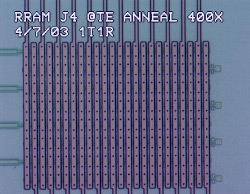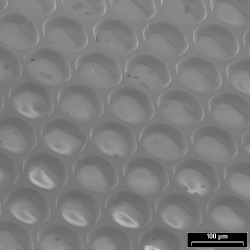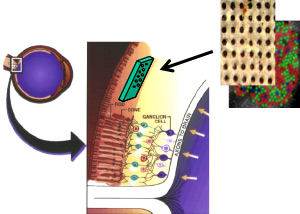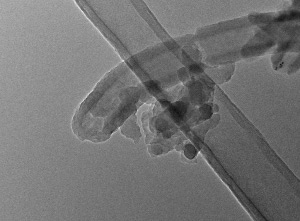Advanced Oxides
Prof. Alex Ignatiev, Project Leader

Resistive Random Access Memory—A novel electrical pulse induced resistance change effect (EPIR) first discovered by the Advanced Oxide research group in perovskite oxides [1] has now been observed in a large number of transition metal oxide thin films, and has caught the attention of the computer memory community. In the EPIR effect, the two-electrode resistance of a metal-oxide-metal thin film capacitor-like device can be dramatically and repeatedly switched between a high resistance state (HRS) and a low resistance state (LRS) by applying short electric pulses with opposite polarities. This effect can be quite large, with a ratio of high resistance state to low resistance state having values of over several orders of magnitude. The mechanism for this resistance change effect has its general basis in the movement of oxygen ion/vacancies in the interface region of the oxide and the metal contact under the application of a pulsed field. Being a resistor, the device has long term stability and retention of state making this resistor system a viable candidate for a new concept in computer memory—resistive random access memory. The current research is inthe preocess of licensing to a company.

High Efficiency Micro Fuel Cells—Solid oxide fuel cells (SOFC) have been rapidly developing for clean and efficient power generation using a variety of fuels because of their high efficiencies. Such fuel cells typically operate at temperatures of 800–1000C, hence, recent focus has been on the reduction of operating temperature for improved long term stability and cost reduction. A micro thin film solid oxide fuel cell (TFSOFC) has been designed and developed in the Project based on thin film deposition and microlithographic processing. The TFSOFC is composed of an ultra-thin film electrolyte grown on a nickel foil substrate and a thin film cathode deposited on the electrolyte. The Ni foil substrate is then processed into a porous anode by photolithographic patterning and etching to develop pores for gas transport into the fuel cell. With the addition of a thin film cathode layer (typically La0.5Sr0.5CoO3) the completed fuel cell shows stable operation in a temperature range as low as 480-570°C, significantly lower than bulk SOFC’s, and a maximum output power density of ~110mW/cm2 in that temperature range yielding a phenomenal 5 W/cm3 power density. Such fuel cells can be applied to portable power needs, distributed power applications and mobile power utilization. The current research is supported by industry and through an international collaboration.

Artificial Retina—Ferroelectric-based IR detectors have been shown to also exhibit sensitivity in the visible range of the electromagnetic spectrum. Such ceramic-based detectors are robust and can operate in caustic environments. As such, these ceramic optical detectors are being developed for biological applications. The microdetectors are light sensitive and have extreme compatibility with biological systems. Thus these unique optical detectors are being applied for use as an Artificial Retina for retinally blind people. The current design is a hexagonal array of microdetectors which are about 5 times the size of human cones. The microdetector arrays can be directly implanted into the eyes of patients with retinal dystrophies such as Retinitis Pigmentosa and Macular Degeneration where retinal “wiring” is still nominally intact, but the eye’s receptors are damaged. Such direct retinal implant of the microdetector array to stimulate retinal cells could allow patients to regain some sight. In such cases additional wiring to the brain cortex is not required, and for the biologically inert ceramic microdetectors, surgical implantation can be quite direct. The microdetectors generate a localized electric field near bipolar cells in the eye thus exciting the retinal neural circuit resulting in a signal at the optic nerve that may be translated by the cortex of the brain as “seeing light”. Several detector materials have exhibited a strong photoresponse in the visible range overlapping eye response from 380 nm to 650 nm. Testing and evaluation continues in anticipation of human trials for the microdetector arrays. The current research is supported by industry.

High Hydrogen Content Materials—A new radiation protection system for astronauts is being developed based on the recently defined unique hydrogen uptake properties of polyaniline (PANI) nanostructures. The possibility of significantly increasing the total amount of hydrogen in PANI and its polymeric nature can make for good structural stability and form stability for shielding elements fabricated from the polymer. Further, the conductive nature of the nanostructured polymer can be additionally useful for possible electrostatic mitigation of ionic species. It is projected that this proposed effort will yield PANI with a high total hydrogen content (>15%) and exceed the current cosmic ray radiation protection offered by polyethylene. The combination of high hydrogen content and active shielding possibilities will result in significantly enhanced radiation protection concepts for astronauts.
Publications
R. Ebrahim, N.J Wu, and A. Ignatiev, “Multi-mode bipolar resistance switching in CuxO”, J. Appl. Physics, 111, 034509 (2012).
Zigui Lu, John Hardy, Jared Templeton, Jeffry Stevenson, Daniel Fisher, Naijuan Wu, and Alex Ignatiev, “Performance of anode-supported solid oxide fuel cell with thin bi-layer electrolyte by pulsed laser deposition”, Journal of Power Sources, 210, 292–296 (2012).
Rabi Ebrahim, R. Mithun Kumar,Nacer Badi ,Naijuan Wu, and Alex Ignatiev, “Filamentary Bipolar Electric Pulse Induced Resistance Switching in Amorphous Silicon RRAM”, J. Vac. Sci. Technol. B 33, 032205 (2015).
J.T. Wang, D. S. Guo, G. L. Zhao, J.C. Chen, Z.W. Sun, and A. Ignatiev, “Graphene-Semicondutdor quantum well with assymetric energy gaps”, World J. Cond. Mat. Phys., 3, 67 (2013).
Rabi Ebrahim Ali Zomorrodian, Naijuan Wu, and Alex Ignatiev, “Copper oxide phase content and its effect on the electric pulse induced resistive switching characteristics of CuxO resistive random access memory (RRAM)”, Thin Sol Films, 539, 337 (2013).
R.E. Beisenov Z.A. Mansurov, S.Zh. Tokmoldin, A. Ignatev. “Epitaxial growth of 3C-SiC films on sapphire (0001) and Si (111) substrates by metal-organic chemical vapor deposition”, Combustion and Plasma Chemistry,. Vol. 10. No. 4. pp. 268-275 (2012).
Rabi Ebrahim, Mukhtar Yeleuov, Ainur Issova, Serekbol Tokmoldin, Alex Ignatiev, “Triple-phase boundary and power density enhancement in thin solid oxide fuel cells by controlled etching of the nickel anode”, Nanoscale Research Letters, 9, 286 (2014).
Rabi Ebrahim, Ramasahayam Mithun Kumar, Nacer Badi, Naijuan Wu and Alex Ignatiev, “Filamentary bipolar electric pulse induced resistance switching in amorphous silicon resistive random access memory”, J. Vac. Sci. Technol. B 33, 032205 (2015).
R. Ebrahim, M. Yeleuov, A. Issova, S. Tokmoldin, and A. Ignatiev, “Thin Solid Oxide Fuel Cell Stack for Low Power Applications”, Intl. J. Eng. Sci. Innov. Tech., 4, 146 (2015).
Alex Ignatiev, R. Ebrahim, M. Yeleuov, D. Fisher, X. Chen, N.J. Wu and S. Tokmoldin, “Nanostructured Thin Film Solid Oxide Fuel Cells”, in Advanced nano depositions and their novel applications, ed: X. Chen (Wiley-VCH Verlag GmbH, 2016).
K. Youg-Fisher, N.J.Wu, and A. Ignatiev, “Conduction Mechanism in Resistance Switching Complex Manganites”, Jap. J Appl. Phys (in print).
R. Ebrahim, A. Zommorodian, A. Ignatiev, “Cyclical Hydrogen Storage and Retention in Polyaniline”, Energy Science Eng, (submitted).
